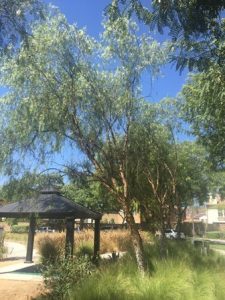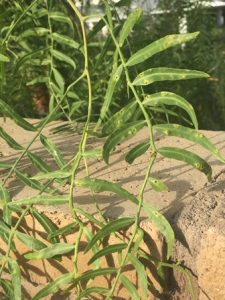Are your pepper trees looking a little peaky? Take a closer look—this tiny bug can make a big impression if left untreated.

Pepper Tree that has been affected by psyllid
The California pepper tree (Schinus molle) is not from California at all. It is native to the Andean deserts of Peru and can be found in Argentina and Chile. It is a dioecious tree meaning that male and female flowers occur on separate plants. So there are boy California peppers and girl California peppers. People have used the tree for a variety of purposes from the construction of saddles by early Spanish settlers to the modern-day use of the berries as pink peppercorns. These peppercorns are often blended with commercial pepper even though they are not related to the black pepper (Piper nigrum). A word of caution: these berries have been reported to cause great discomfort in small children.

Pitted leaves indicate possible psyllid infestation
You may notice that from time to time certain pepper trees drop more leaves than is normal for this evergreen tree. The closer you are to the coast the greater this phenomenon may be. The cause of this can be many things, including the peppertree psyllid (Calophya schini). This pest is native to Peru where it is under biological control. It has recently been reported in Portugal. It was first reported in California in Long Beach in 1984. Since its discovery in California it has made its way north to San Francisco and south to San Diego. It is indeed a well-travelled pest!
The nymphal stage of the pest is when damage occurs. A deep pit is made in the foliage and many pits may be seen on individual leaflets. The pest can also be found on flower buds, leaf stems, small green twigs and sometimes more mature wood. The trees are disfigured by the leaf distortion caused by the pitting and when the psyllid population is high it can cause a gray cast to envelop the tree. High populations can also cause prolific leaf drop.
There are treatments available for this pest and a well-timed application can help keep the tree healthy and vigorous during the growing season. Contact our Plant Health Care Department for more information
 -Tim Clancy, Consulting Arborist
-Tim Clancy, Consulting Arborist
Certified Arborist (WE-0806A)
Tree Risk Assessment Qualified (TRAQ)
Qualified Applicator License (QAL)
